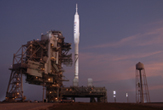Bad Weather Keeps NASA Rocket Test on Hold

CAPE CANAVERAL, Fla. - Bad weather continues to plagueNASA?s experimental Ares I-X test rocket as the space agency tries to launchthe new booster on a critical test flight for the second day in a row.
The $445million rocket's launch window opened at 8 a.m. EDT (1200 GMT), but highclouds and countdown delays have kept it on the ground so far. Weather officerKathy Winters has predicted a 40 percent chance of conditions good enough tolaunch today, so mission managers are still holding out hope that a break inthe clouds will come. NASA has until 12 p.m. EDT (1600GMT) to try to launch Ares I-X today.
NASA is requiring good visibility and nary a cloud in sightfor this first flight of the untried rocket. If the rocket travels through highclouds it runs a risk of triggering "trioboelectrification" - staticelectricity that could interfere with sensitive onboard instruments.
Tuesday night a thunderstorm passed over the launch pad, andabout 150 lightning strikes were seen to fall nearby, with four strikes hittingwithin about a half mile of the rocket. Wednesday's countdown was delayed whilecrews checked out the rocket's systems to make sure they hadn't been impacted.
"We had to go verify a lot of things to verify therocket is still good to go fly," said Ares I-X deputy mission manager JonCowart. "We looked at all the systems that could have been affected bythis and all the data indicates that there was absolutely no real effect."
A first launch try on Tuesday wasstymied by clouds, winds and the threat of rain. In addition to those concerns,a stuck cover on one of the rocket's probes stalled Tuesday morning, furtherdelaying the countdown, and a freight boat later strayed into restricted watersclose to the launch pad, thwarting one launch attempt.
The mission is a trial run for the Ares I vehicle slated totransport astronauts to low-Earth orbit and on to themoon. This unmanned flight will be the first test of the rocket's designand configuration, and engineers plan to analyze readings from over 700 sensorson the booster to study its performance.
Get the Space.com Newsletter
Breaking space news, the latest updates on rocket launches, skywatching events and more!
The 327-foot(100-meter) tall rocket is designed to burn its engines for just over twominutes, before its first and second stages separate and drop into the AtlanticOcean. Retrieval boats are in place to collect the solid rocket first stage,which contains many of the sensors loaded with data from the trip. The dummysecond stage - designed to mimic the size and weight of the real stage intendedfor Ares I - is destined to sink into the sea.
If NASA does not launch the AresI-X test rocket this week, it could be delayed until mid-November, missionmanagers have said.
- Video - Ares I-X Rocket Rolls to Launch Pad, Test Flight Plan
- Stacking Up the World's Tallest Rockets
- Video Show - NASA's Vision for Humans in Space
SPACE.com will provide full coverage of NASA's Ares I-Xtest flight with Staff Writer Clara Moskowitz in Cape Canaveral, Fla., andManaging Editor Tariq Malik in New York. Clickhere for full mission coverage.
Join our Space Forums to keep talking space on the latest missions, night sky and more! And if you have a news tip, correction or comment, let us know at: community@space.com.

Clara Moskowitz is a science and space writer who joined the Space.com team in 2008 and served as Assistant Managing Editor from 2011 to 2013. Clara has a bachelor's degree in astronomy and physics from Wesleyan University, and a graduate certificate in science writing from the University of California, Santa Cruz. She covers everything from astronomy to human spaceflight and once aced a NASTAR suborbital spaceflight training program for space missions. Clara is currently Associate Editor of Scientific American. To see her latest project is, follow Clara on Twitter.










